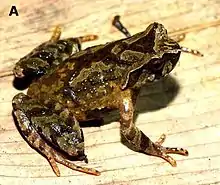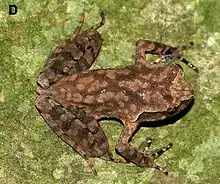Megophrys cheni
Megophrys cheni is a species of frog in the family Megophryidae.[3][2][4] It is endemic to the middle Luoxiao Mountains at the border of Jiangxi and Hunan provinces in south-eastern China.[1][3][2] Its specific name honours Chen Chunquan, former director of the Jinggang National Nature Reserve.[3]
| Megophrys cheni | |
|---|---|
 | |
| Holotype of Megophrys cheni (male) | |
| Scientific classification | |
| Kingdom: | Animalia |
| Phylum: | Chordata |
| Class: | Amphibia |
| Order: | Anura |
| Family: | Megophryidae |
| Genus: | Megophrys |
| Species: | M. cheni |
| Binomial name | |
| Megophrys cheni (Wang and Liu, 2014) | |
| Synonyms[2] | |
| |
Description
Males measure 26–30 mm (1.0–1.2 in) and females 32–34 mm (1.3–1.3 in) in snout–vent length. The snout is short. The tympanum is distinct or indistinct, partly hidden by the swollen, light-coloured supratympanic fold. The skin of upper surfaces and flanks is smooth with tubercles; tubercles usually form dorsolateral rows, with a weak, X-shaped ridge between them, and four–five transverse rows on shanks. There is a small, horn-like tubercle at the edge of the eyelid. Ventral surface is smooth. Colouration above is red brown or olive brown, with the dorsum bearing a dark, reticular marking.[3]
Males have a single vocal sac. Based on calling males, reproductive season is April–September. Tadpoles are unknown.[3]

Distribution and habitat
This newly described species is known from three locations on the Luoxiao Mountains: Jingzhushan (the type locality) on the Jinggang Mountains in Jiangxi, and Dayuan and Lishuzhou, both in the Yanling Taoyuandong National Nature Reserve, Hunan. It lives in mountainous swamps surrounded by subtropical moist evergreen broadleaf forests at elevations of 1,200–1,530 m (3,940–5,020 ft) asl.[3]
Two other Megophrys species occur in the area, but the three species differ in their habitats: Megophrys jinggangensis live in slow-moving streams at 700–850 m (2,300–2,790 ft) asl, and Megophrys lini in rushing streams at 1,100–1,610 m (3,610–5,280 ft) asl. The species also differ in the characteristics of the male advertisement calls.[3]
References
- IUCN SSC Amphibian Specialist Group (2020). "Megophrys cheni". IUCN Red List of Threatened Species. 2020: e.T78519846A122172262. Retrieved 23 May 2020.
- Frost, Darrel R. (2020). "Megophrys cheni (Wang and Liu, 2014)". Amphibian Species of the World: an Online Reference. Version 6.1. American Museum of Natural History. doi:10.5531/db.vz.0001. Retrieved 23 May 2020.
- Wang, Yingyong; Zhao, Jian; Yang, Jianhuan; Zhou, Zhixin; Chen, Guoling & Liu, Yang (2014). "Morphology, molecular genetics, and bioacoustics support two new sympatric Xenophrys toads (Amphibia: Anura: Megophryidae) in southeast China". PLoS ONE. 9 (4): e93075. doi:10.1371/journal.pone.0093075. PMC 3979665. PMID 24714161.
- "Megophrys cheni (Wang and Liu, 2014)". AmphibiaChina (in Chinese). Kunming Institute of Zoology. 2016. Retrieved 30 May 2016.

